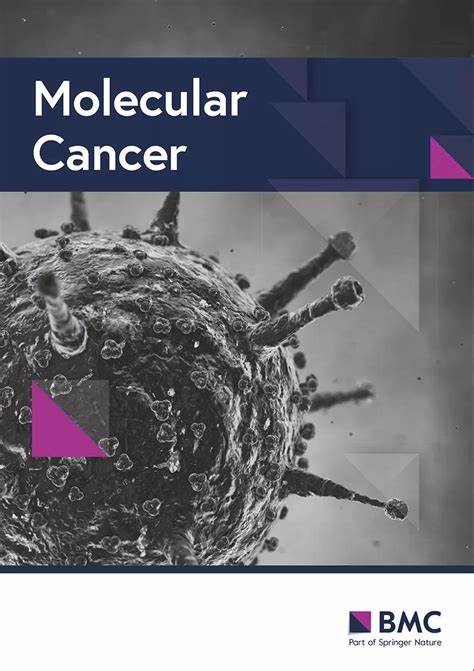基于转化模型的证据表明,在非小细胞肺癌治疗中,标准治疗药物与抗微生物RNA-155联用可增强疗效
IF 27.7
1区 医学
Q1 BIOCHEMISTRY & MOLECULAR BIOLOGY
引用次数: 0
摘要
非小细胞肺癌(NSCLC)中微RNA-155(miR-155)表达的升高会促进顺铂耐药,并对治疗效果产生负面影响。然而,miR-155 还能通过抑制 PD-L1 的表达来增强抗肿瘤免疫力。由于 miR-155 的双重分子效应,通过其拮抗剂 anti-miR-155 来靶向治疗 miR-155 已被证明具有挑战性。我们开发了一个多尺度机理模型,通过体内数据进行校准,然后外推至人体,以研究纳米颗粒递送的抗-miR-155 在 NSCLC 中单独或与标准治疗药物联用的治疗效果。模型模拟和临床情景分析表明,每三周一次、剂量为2.5 mg/kg的抗miR-155单药疗法具有很强的抗癌活性。该疗法的中位无进展生存期(PFS)为6.7个月,与顺铂和免疫检查点抑制剂相比效果更佳。此外,我们还探索了抗miR-155与标准治疗药物的组合,并发现了具有强烈协同作用的两药和三药组合。抗-miR-155、顺铂和pembrolizumab的三药联合疗法的中位PFS为13.1个月,而抗-miR-155和顺铂的两药联合疗法的中位PFS为11.3个月。我们的分析还为药物组合的不利剂量比提供了有价值的见解,强调了优化剂量方案以防止拮抗作用的必要性。这项研究填补了抗miR-155临床前开发与临床转化之间的空白,揭示了抗miR-155联合疗法在NSCLC中的潜力。本文章由计算机程序翻译,如有差异,请以英文原文为准。
Translational modeling-based evidence for enhanced efficacy of standard-of-care drugs in combination with anti-microRNA-155 in non-small-cell lung cancer
Elevated microRNA-155 (miR-155) expression in non-small-cell lung cancer (NSCLC) promotes cisplatin resistance and negatively impacts treatment outcomes. However, miR-155 can also boost anti-tumor immunity by suppressing PD-L1 expression. Therapeutic targeting of miR-155 through its antagonist, anti-miR-155, has proven challenging due to its dual molecular effects. We developed a multiscale mechanistic model, calibrated with in vivo data and then extrapolated to humans, to investigate the therapeutic effects of nanoparticle-delivered anti-miR-155 in NSCLC, alone or in combination with standard-of-care drugs. Model simulations and analyses of the clinical scenario revealed that monotherapy with anti-miR-155 at a dose of 2.5 mg/kg administered once every three weeks has substantial anti-cancer activity. It led to a median progression-free survival (PFS) of 6.7 months, which compared favorably to cisplatin and immune checkpoint inhibitors. Further, we explored the combinations of anti-miR-155 with standard-of-care drugs, and found strongly synergistic two- and three-drug combinations. A three-drug combination of anti-miR-155, cisplatin, and pembrolizumab resulted in a median PFS of 13.1 months, while a two-drug combination of anti-miR-155 and cisplatin resulted in a median PFS of 11.3 months, which emerged as a more practical option due to its simple design and cost-effectiveness. Our analyses also provided valuable insights into unfavorable dose ratios for drug combinations, highlighting the need for optimizing dose regimens to prevent antagonistic effects. This work bridges the gap between preclinical development and clinical translation of anti-miR-155 and unravels the potential of anti-miR-155 combination therapies in NSCLC.
求助全文
通过发布文献求助,成功后即可免费获取论文全文。
去求助
来源期刊

Molecular Cancer
医学-生化与分子生物学
CiteScore
54.90
自引率
2.70%
发文量
224
审稿时长
2 months
期刊介绍:
Molecular Cancer is a platform that encourages the exchange of ideas and discoveries in the field of cancer research, particularly focusing on the molecular aspects. Our goal is to facilitate discussions and provide insights into various areas of cancer and related biomedical science. We welcome articles from basic, translational, and clinical research that contribute to the advancement of understanding, prevention, diagnosis, and treatment of cancer.
The scope of topics covered in Molecular Cancer is diverse and inclusive. These include, but are not limited to, cell and tumor biology, angiogenesis, utilizing animal models, understanding metastasis, exploring cancer antigens and the immune response, investigating cellular signaling and molecular biology, examining epidemiology, genetic and molecular profiling of cancer, identifying molecular targets, studying cancer stem cells, exploring DNA damage and repair mechanisms, analyzing cell cycle regulation, investigating apoptosis, exploring molecular virology, and evaluating vaccine and antibody-based cancer therapies.
Molecular Cancer serves as an important platform for sharing exciting discoveries in cancer-related research. It offers an unparalleled opportunity to communicate information to both specialists and the general public. The online presence of Molecular Cancer enables immediate publication of accepted articles and facilitates the presentation of large datasets and supplementary information. This ensures that new research is efficiently and rapidly disseminated to the scientific community.
 求助内容:
求助内容: 应助结果提醒方式:
应助结果提醒方式:


